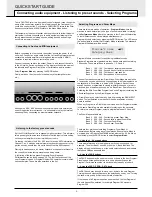
When controlling Volume, these controls adjust the following phases of
the Envelope as shown in the illustration.
A = Attack Time
Adjusts the time it takes when a key is pressed for the envelope to climb
from zero to full volume. It can be used to create a sound with a slow fade
in.
D = Decay Time
Adjusts the time it takes for the envelope to decay from full volume to the
level set by the Sustain control while a key is held down.
S = Sustain Level
Sets the volume level that the envelope remains at while the key is held
down, after the Decay time has expired.
R = Release Time
Adjusts the time it takes when key is released from the Sustain level to
zero. It can be used to create sounds that slowly fade away in volume.
A typical synthesizer will have one or more envelopes. One envelope is
always applied to the amplifier to shape the volume of each note played.
Additional envelopes can be used to dynamically alter other sections of
the synthesizer during the lifetime of each note.
The KS 4 / KS 5 has a second Envelope Generator which may be applied
in various interesting ways. For example, it may typically be used to modi-
fy the filter cut off frequency or change an oscillators pitch during the life-
time of a note.
LFOs
Like the Envelope Generators, the LFO section on a synthesizer is a
Modulator.
That is to say, instead of forming a part of the sound synthesis
process, it is used instead to change (modulate) other synthesizer sec-
tions. For example, altering the Oscillator pitch or Filter cutoff frequency.
Most musical instruments produce sounds that vary not just in volume but
also in pitch and timbre. Sometimes this variation can be quite subtle, but
still contribute greatly towards shaping the final sound.
Where an Envelope is used to control a one-off modulation which occurs
during the lifetime of a single note, LFOs modulate by using a cyclic
repeating wave pattern. As discussed earlier, Oscillators produce a con-
stant waveform which can take the shape of a repeating sine wave, trian-
gle wave etc. LFOs produce waveforms in a similar way, but at a frequen-
cy normally too low to produce an audible pitched vibration that the
human ear can perceive. In fact, LFO actually stands for Low Frequency
Oscillator.
As with an Envelope, the waveforms generated by the LFOs may be fed
to other parts of the synthesizer to create the desired movements in the
sound.
There are two independent LFOs available which may be used to modu-
late different synthesizer sections and run at different speeds.
A typical waveshape for an LFO would be a Triangle wave.
Imagine this slow moving wave being applied to an Oscillator’s pitch. The
result would be that the pitch of the Oscillator slowly rises and falls above
and below its original pitch.
This would simulate, for example, a violinist moving a finger up and down
the string of the instrument whilst it is being bowed. This subtle up and
down movement of pitch is referred to as the ‘Vibrato’ effect.
Similarly, if the same LFO were applied to the Filter Cutoff frequency
instead of the Oscillator pitch, a similar wobbling effect known as ‘wow-
wow’ would be heard.
As well as LFOs being available to modify (or more commonly known as
Modulate
) different sections of the synthesizer, additional Envelopes may
also be used simultaneously.
Clearly, the more Oscillators, Filters, Envelopes and LFOs there are in a
Synthesizer, the more powerful it becomes.
SYNTHESIS TUTORIAL
Envelopes and Amplifier - LFOs
•
13
•
Attack
Decay
Release
Sustain
Key "On"
Key "Off"
Time
Volume
Key “On”
Key “Off”
Volume
Attack Decay
Release
Sustain
Level
Time
Time
Pitch












































